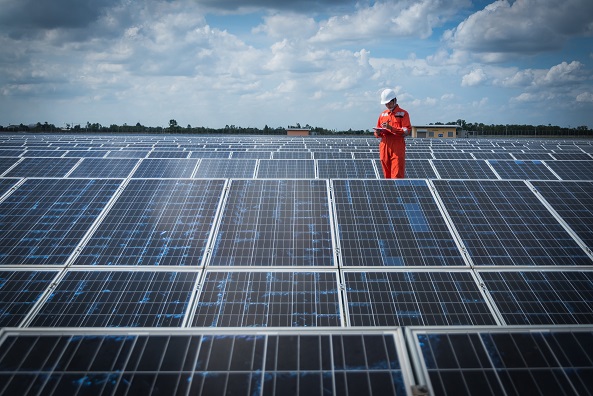The Energy Transition | New balancing reserve service approved by Ofgem
Published on 19th February 2024
Welcome to our top picks of the latest energy regulatory and market developments in the UK's transition to net zero

This week we look at Ofgem's approval of a new balancing reserve service, the government's international collaboration with Canada and other partners on fusion energy, Ofgem's latest tender for the ownership of offshore transmission assets and more.
Ofgem approves new balancing reserve service
Ofgem has approved a new Balancing Reserve (BR) service which will go live next month. The service will allow the Electricity System Operator (ESO) to secure energy a day in advance rather than buying it on the day. The ESO will purchase energy from Balancing Mechanism (BM) generators that can generate more than 1MW and will commit to paying generators a guaranteed sum agreed at daily auctions for each 30-minute settlement period they participate in.
This announcement follows the news last week that the ESO would allow up to 300MW of aggregated assets into the BM. Ofgem's tweaks to both the BM and BR are designed to improve the efficiency of the grid, ultimately leading to reduced costs for consumers and less waste. A cost-benefit analysis conducted by the ESO has found that the reforms could deliver £639 million of savings for consumers over the next four years in the base case, and up to £821 million in the best case.
The ESO said in a statement: "BR will enable the ESO to procure firm Regulating Reserve capacity through a Day Ahead auction, both reducing balancing costs and providing improved system security by guaranteeing headroom (reduced consumption or increased generation) and footroom (reduced generation or increased consumption) for the Control Room to access when needed."
Fusion energy partnership announced between UK and Canada
The UK and Canada have signed a joint Memorandum of Understanding (MoU) on fusion energy. The MoU was signed by Energy Secretary, Claire Coutinho, and Canadian Minister of Energy and Natural Resources, Jonathan Wilkinson, at an International Energy Agency's (IEA) Ministerial Meeting. The collaboration will focus on: research and development; regulatory harmonisation; and skills and workforce development for fusion energy.
Fusion energy involves combining two forms of hydrogen and heating them to extreme temperatures, resulting in the release of energy that can be harnessed to generate electricity. This form of energy generation is significantly more efficient and cleaner than burning coal, oil, or gas. The partnership between the UK and Canada aims to advance fusion technology, contribute to global efforts to achieve net zero emissions, and ensure long-term energy independence.
This collaboration follows the UK's previous partnership with the United States on fusion energy and supports the UK's £650 million Fusion Futures programme, which focuses on innovation, training, and funding for fusion companies. Additionally, the UK Atomic Energy Authority and the Canadian Nuclear Laboratories have announced a new collaboration agreement. This agreement establishes a framework for joint research projects, personnel secondments, expertise sharing, and provision of services to the fusion industry.
Energy Security Secretary Claire Coutinho said: “The UK is leading the world in fusion research, which could provide a near limitless supply of clean energy. This landmark partnership with Canada will strengthen co-operation between our countries and support our record-breaking British research – bringing us closer to making fusion a reality.”
Ofgem announces largest Offshore Transmission Tender Round to date
Ofgem is inviting investors to bid for ownership of 1.2GW of transmission assets at Dogger Bank B wind farm. The tender has been initiated under the Offshore Transmission Owners process which invites investors to bid to own and operate offshore transmission assets.
Offshore transmission assets comprise the offshore substation which receives power from the generation asset, the subsea cable connected to the onshore substation, and the connection to the onshore substation. Investors can pick which offshore transmission assets they bid for from those that are on offer. Successful bidders are awarded an offshore transmission licence.
The Dogger Bank B assets which are on offer in this tender are worth an estimated £1 billion and form the largest phase of the Dogger Bank Wind Farm, which will be the world's largest offshore wind farm once operational.
Investors will be selected based on their financial position, technical experience and style of management and operation. They are guaranteed tenure for 25 years if successful in their bids, though revenue is subject to availability, and penalties are imposed for underperformance. Availability is the key metric, with target availability set at 98%. Ofgem has confirmed that revenue will not be linked to the output of the windfarms connected to the offshore substation.
This Tender Round 11 tender was launched on 14 February 2024 with bidding process to follow.
Ofgem launches consultation on Generation Licence regulations
Ofgem has launched a consultation on potential changes to the electricity generation licence to ensure that it is fit for purpose where assets are classed as generation but also provide network services. In the consultation document, the regulator acknowledges that the procurement of network services is a key tenet of the ESO's strategy for a zero-carbon electricity system, and that questions have been raised as to the suitability of the current regulatory treatment of these assets.
In an open letter to the industry in October 2021, Ofgem committed to reviewing the regulatory framework applicable to ancillary service assets such as synchronous condensers. Currently, these assets are eligible to apply for generation licences since they store energy to provide system stability services rather than final demand. Ofgem states that issues have arisen with this treatment through ESO's tender processes, and Ofgem now acknowledges that some of the Standard Licence conditions may require modification to ensure the suitability of the Generation Licence framework to these assets. Through the consultation, Ofgem aims to ensure that innovative new technologies are not prevented from providing services to ESO in the future.
The consultation is open until 10 March 2024 and Ofgem is particularly interested to hear the views of stakeholders with an interest in generation licences, and how network services are provided to the system operator. Ofgem also intends to publish a policy level review within the next few months which will consider the best options for the short and medium term.
This week's article was written with the assistance of Yasmin Howes, Projects Associate, Johnny Hartrick, Jack Duffy and Luke Webb, Trainee Solicitors.





